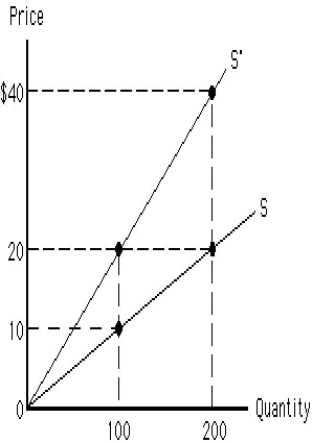A) price elasticity has an absolute value of 1.
B) price elasticity has an absolute value greater than 1.
C) price elasticity has an absolute value less than 1.
D) price elasticity is negative.
E) consumers do not respond to a change in price.
Correct Answer

verified
Correct Answer
verified
Multiple Choice
A university administration's decision to raise tuition in order to increase revenue will be successful if:
A) the demand curve slopes downward.
B) demand is elastic.
C) demand is inelastic.
D) supply is elastic.
E) supply is inelastic.
Correct Answer

verified
Correct Answer
verified
Multiple Choice
Demand is inelastic only if the price elasticity of demand has an absolute value:
A) of 1.
B) greater than 1.
C) greater than 0 but less than 1.
D) greater than 0.
E) greater than 5.
Correct Answer

verified
Correct Answer
verified
Multiple Choice
If demand is unit elastic, a price reduction will:
A) increase revenues.
B) reduce revenues.
C) reduce total cost.
D) have no effect on revenues.
E) increase profits.
Correct Answer

verified
Correct Answer
verified
Multiple Choice
Luis wonders why commercials appear more frequently at the end of a TV movie than at the beginning. Carol says that this pattern can be explained by the:
A) amount of time Luis spends watching TV.
B) length of the adjustment period.
C) cost of supplying additional minutes of the movie.
D) high elasticity of demand for watching the end of a TV movie.
E) availability of substitutes for the TV movie.
Correct Answer

verified
Correct Answer
verified
True/False
Necessities and luxuries are both types of normal goods.
Correct Answer

verified
Correct Answer
verified
True/False
Elasticity rises as price falls along a linear downward-sloping demand curve.
Correct Answer

verified
Correct Answer
verified
Multiple Choice
An inferior good is:
A) any good of low quality.
B) one that consumers buy less of as the price rises.
C) one that consumers buy less of as their income rises.
D) one that has few substitutes.
E) any good made with inexpensive inputs.
Correct Answer

verified
C
Correct Answer
verified
Multiple Choice
Elasticity is always _____.
A) measured in dollars
B) measured in utils
C) measured in units of quantity
D) measured in pounds
E) independent of the units of measurement for price and quantity
Correct Answer

verified
E
Correct Answer
verified
Multiple Choice
In order to prove that macaroni is an inferior good, we could test the _____ of macaroni and get a _____.
A) cross-price elasticity; negative number.
B) income elasticity; number less than 1.
C) income elasticity; positive number.
D) price elasticity of demand; number greater than negative 1.
E) income elasticity; negative number.
Correct Answer

verified
Correct Answer
verified
Multiple Choice
All other things constant, if a _____ proportion of a consumer's budget is spent on a good, the demand for the good will be more _____ and a consumer will purchase a substitute instead.
A) greater; price elastic
B) smaller; unit elastic
C) smaller; price elastic
D) greater; price inelastic
E) greater; stable
Correct Answer

verified
Correct Answer
verified
Multiple Choice
A successful advertising campaign is most likely to:
A) increase the price elasticity of demand by stressing upon the uniqueness of the product.
B) reduce the price elasticity of demand by stressing upon the uniqueness of the product.
C) reduce the price elasticity of demand by informing consumers about the availability of substitutes.
D) have no effect on the demand curve.
E) make the demand curve shift inward.
Correct Answer

verified
Correct Answer
verified
Multiple Choice
A common determinant of both the price elasticity of demand and the price elasticity of supply for a product is:
A) the availability of close substitutes for the product.
B) the proportion of the consumer's budget spent on the product.
C) the length of the adjustment period considered.
D) the additional cost of increasing production.
E) the availability of substitutes in production for the product.
Correct Answer

verified
Correct Answer
verified
Multiple Choice
If a firm raises the price of its product, its total revenue will:
A) always increase.
B) increase only if demand is price inelastic.
C) increase only if demand is price elastic.
D) remain constant regardless of the price elasticity of demand.
E) never increase.
Correct Answer

verified
Correct Answer
verified
True/False
Substitutes are pairs of goods that have a positive cross-price elasticity of demand.
Correct Answer

verified
Correct Answer
verified
Multiple Choice
Figure 5.10 shows two upward-sloping linear supply curves that pass through the origin. The price elasticity of supply between $10 and $20 on the supply curve S is _____. Figure 5.10

A) 0
B) infinity
C) 1
D) 2
E) 10
Correct Answer

verified
Correct Answer
verified
Multiple Choice
Demand is inelastic if:
A) the percentage change in price is greater than the percentage change in quantity demanded.
B) the percentage change in price is less than the percentage change in quantity demanded.
C) the percentage change in price is equal to the percentage change in quantity demanded.
D) the value of price elasticity is equal to −1.
E) the value of price elasticity is less than −1.
Correct Answer

verified
Correct Answer
verified
True/False
The larger the proportion of a consumer's budget that is spent on a product, the more the consumer will demand a substitute.
Correct Answer

verified
Correct Answer
verified
True/False
If the demand curve shifts, but the supply curve does not, and the price remains the same, supply must be perfectly inelastic.
Correct Answer

verified
Correct Answer
verified
Multiple Choice
A 5 percent increase in income leads to a 10 percent increase in the quantity demanded for a service. This service is a(n) _____ good, and the demand is _____.
A) normal; elastic
B) normal; inelastic
C) normal; unit elastic
D) inferior; elastic
E) inferior; inelastic
Correct Answer

verified
A
Correct Answer
verified
Showing 1 - 20 of 149
Related Exams